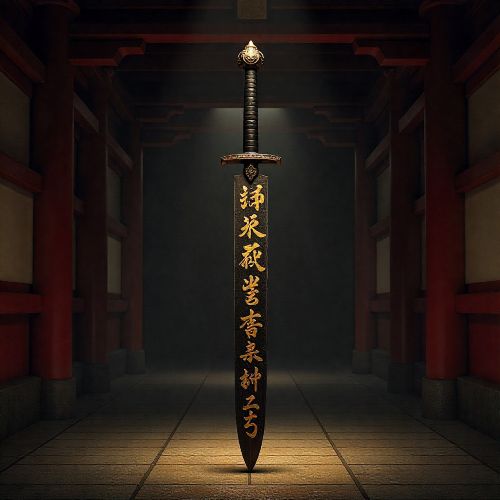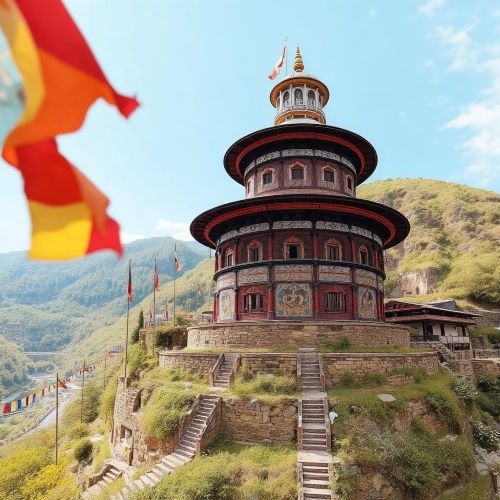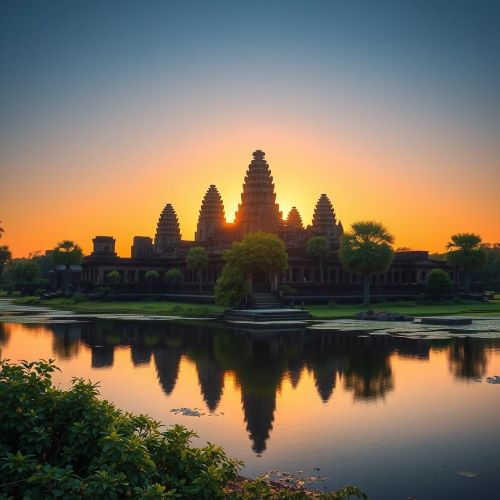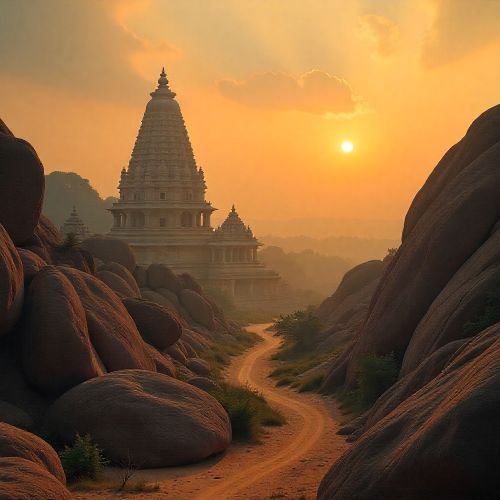Padmanabhaswamy Temple : The Treasure Trove
At a glance
| Description | |
|---|---|
| Mythology | Indian Mythology |
| Country | India |
| Closest airport | Thiruvananthapuram International Airport (TRV) |
| Type | Constructed |
| Accessibility | 10/10 |
Introduction
The Padmanabhaswamy Temple in Thiruvananthapuram, Kerala, stands as a dazzling fusion of divine devotion, ancient craftsmanship, and royal heritage. Dedicated to Lord Vishnu, it is celebrated as one of the 108 Divya Desams—the most sacred shrines of Vishnu worshipped by devotees across India. Its recorded history stretches back over a millennium, with roots possibly reaching into the Sangam era. Over time, the temple has transformed from a modest shrine into a monumental religious landmark, thanks to centuries of royal patronage and architectural enhancement. Today, it captivates not just pilgrims but also historians, architects, and travelers drawn by its spiritual aura and enigmatic treasures.
Connection with Mythology
The mythology surrounding Padmanabhaswamy Temple is as intricate as the carvings on its towering gopuram. Central to its legend is Lord Vishnu in his Anantashayana form—reclining on the endless serpent Ananta, with a lotus emerging from his navel, upon which Brahma is seated. This cosmic imagery symbolizes creation itself. Local tradition recounts that the sage Divakara Muni once encountered Vishnu disguised as a playful child. When the boy disappeared into a massive tree, it collapsed into the form of the deity stretched across miles of land. The sage prayed for the divine presence to remain, leading to the temple’s consecration. Another layer of legend ties the temple to Parasurama, the warrior-sage who is believed to have consecrated the idol and entrusted its guardianship to Brahmin families. This seamless blend of cosmic myth and local lore gives the temple an unmatched spiritual depth, where each ritual echoes stories from antiquity.
Ways to Get There
Reaching Padmanabhaswamy Temple is straightforward due to its central location in Thiruvananthapuram’s East Fort. Thiruvananthapuram International Airport lies barely 7 kilometers away, with taxis and autos offering quick transfers. For rail travelers, Thiruvananthapuram Central Railway Station is just a short walk from the temple complex, making it one of the most accessible pilgrim destinations in India. Road connectivity is equally efficient, with buses and taxis from all parts of the city converging at East Fort. Nearby landmarks such as Kovalam Beach and the Napier Museum make it easy for visitors to combine spiritual exploration with cultural sightseeing.
What to Look For
From the moment you pass through its 100-foot, seven-tiered gopuram, Padmanabhaswamy Temple immerses you in an atmosphere where devotion meets artistry. The idol of Lord Vishnu, stretching 18 feet in length, is a marvel of religious sculpture—crafted from over twelve thousand sacred shaligrams brought from Nepal and coated with a unique Ayurvedic plaster for preservation. This colossal image can be seen only through three separate doorways, each framing a portion of the deity: the head and Shiva lingam, Brahma on the lotus, and the feet resting on the serpent coils. The Ottakkal Mandapam, a single granite slab serving as a platform for rituals, and the serene Padma Theertham tank are integral to the temple’s daily worship. Equally fascinating are its legendary underground vaults, some of which were opened in 2011, revealing treasures of unimaginable value—yet one, Vault B, remains sealed, shrouded in mystery and guarded by lore.
Need a place to stay? Book your hotel room now!
Importance in cultural history
Padmanabhaswamy Temple is far more than a site of worship—it is a living testament to Kerala’s spiritual identity and historical continuity. Its connection with the Travancore royal family is unparalleled. In 1750, Maharaja Marthanda Varma dedicated his entire kingdom to Lord Padmanabha, ruling thereafter as the deity’s servant, or “Padmanabha Dasa.” This unique act of surrender transformed the governance of Travancore into a theocratic monarchy, with the deity symbolically presiding over the land. The temple also played a role in progressive social change, most notably during the Temple Entry Proclamation of 1936, which granted all Hindus, regardless of caste, the right to worship within its sacred walls. Its mention in ancient texts like the Vishnu Purana, Padma Purana, and Tamil Alvar hymns confirms its enduring place in the literary and devotional heritage of South India. The temple’s architectural style—an elegant blend of Kerala and Dravidian forms—has influenced temple design across the region, making it a benchmark for religious artistry.
Best time to travel
The most rewarding period to visit Padmanabhaswamy Temple is from October to February, when the weather is pleasantly cool and conducive to long hours of exploration. These months also coincide with several temple festivals, each adding a layer of cultural richness to the experience. The Painkuni Utsavam in March–April features grand processions and the symbolic Palliveta ritual, while the Alpasi Utsavam in October–November includes the sacred Aaratt procession, where deities are ceremonially bathed in the sea. Navaratri, celebrated with devotional music and dance, is another vibrant occasion to witness the temple at its cultural peak. Avoiding the monsoon months of June to September is advisable, as heavy rains can disrupt travel and limit outdoor activities.
Visitors to Padmanabhaswamy Temple should be prepared for a strictly traditional environment. Men are required to wear a mundu or dhoti without shirts, while women must wear sarees or long skirts with blouses; modern attire is not permitted inside the temple premises. Footwear is left outside, and photography is strictly prohibited to preserve the sanctity of the interiors. The temple opens before dawn, with the first darshan, Nirmalya Darshanam, taking place at 3:15 AM, followed by several viewing sessions throughout the morning and evening. Entry for general darshan is free, though special pooja services may require a fee. Given the temple’s popularity, arriving early ensures a peaceful experience. For those combining the visit with sightseeing, nearby attractions like Sree Chitra Art Gallery and Kuthiramalika Palace Museum provide an enriching complement to the spiritual journey.
Source
Gayatri Heritage. (2025, January 7). The Sacred Legacy of Sree Padmanabhaswamy Temple: History, Mythology, and Architectural Grandeur. Retrieved from https://gayatriheritage.com/blogs/our-blogs/the-sacred-legacy-of-sree-padmanabhaswamy-temple-history-mythology-and-architectural-grandeur
Wikipedia contributors. (n.d.). Padmanabhaswamy Temple. Wikipedia. Retrieved August 9, 2025, from https://en.wikipedia.org/wiki/Padmanabhaswamy_Temple
Savaari. (2024, August 9). Things to do in Padmanabhaswamy Temple: A complete travel guide. Retrieved from https://www.savaari.com/blog/things-to-do-in-padmanabhaswamy-temple/
Kerala Tourism. (n.d.). Padmanabhaswamy Temple Trivandrum. Retrieved from https://keralatourism.travel/padmanabhaswamy-temple-trivandrum
TravelSetu. (n.d.). Best Time To Visit Padmanabhaswamy Temple. Retrieved from https://travelsetu.com/guide/padmanabhaswamy-temple-tourism/best-time-to-visit-padmanabhaswamy-temple
Thrillophilia. (n.d.). Sree Padmanabhaswamy Temple: How To Reach, Best Time & Tips. Retrieved from https://www.thrillophilia.com/attractions/sree-padmanabhaswamy-temple
Frequently Asked Questions
Lorem ipsum dolor sit amet, consectetur adipiscing?
Lorem ipsum dolor sit amet, consectetur adipiscing elit. Praesent convallis vestibulum justo, ac tincidunt nunc vehicula quis. Nullam id dolor quis orci malesuada feugiat. Curabitur aliquet libero at urna ullamcorper, ac ultricies nulla dapibus.
Lorem ipsum dolor sit amet, consectetur adipiscing?
Lorem ipsum dolor sit amet, consectetur adipiscing elit. Praesent convallis vestibulum justo, ac tincidunt nunc vehicula quis. Nullam id dolor quis orci malesuada feugiat. Curabitur aliquet libero at urna ullamcorper, ac ultricies nulla dapibus.
Lorem ipsum dolor sit amet, consectetur adipiscing?
Lorem ipsum dolor sit amet, consectetur adipiscing elit. Praesent convallis vestibulum justo, ac tincidunt nunc vehicula quis. Nullam id dolor quis orci malesuada feugiat. Curabitur aliquet libero at urna ullamcorper, ac ultricies nulla dapibus.
Lorem ipsum dolor sit amet, consectetur adipiscing?
Lorem ipsum dolor sit amet, consectetur adipiscing elit. Praesent convallis vestibulum justo, ac tincidunt nunc vehicula quis. Nullam id dolor quis orci malesuada feugiat. Curabitur aliquet libero at urna ullamcorper, ac ultricies nulla dapibus.
Lorem ipsum dolor sit amet, consectetur adipiscing?
Lorem ipsum dolor sit amet, consectetur adipiscing elit. Praesent convallis vestibulum justo, ac tincidunt nunc vehicula quis. Nullam id dolor quis orci malesuada feugiat. Curabitur aliquet libero at urna ullamcorper, ac ultricies nulla dapibus.









